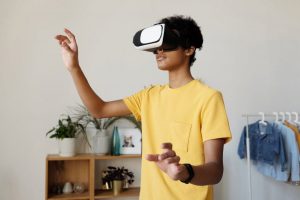As the world has suddenly embraced online learning due to the COVID-19 virus, now is a good time to explore current trends in the world of eLearning.
According to an article by Jitender Kumar that was posted on the eLearning Industry website, immersive learning is a relatively new teaching technique that could have a profound impact on the future of learning.
 What Is Immersive Learning?
What Is Immersive Learning?
According to Mr. Kumar, immersive learning is a technique that makes use of an artificial or simulated environment through which the learners can become completely immersed in the learning process.
In short, immersive learning would use technology to create a digital virtual learning environment that would allow the student to become fully immersed in the learning experience. Unlike more traditional “lesson based” learning techniques where students learn via lessons taught in a classroom, immersive learning would place a student in real life situations where the outcome would be controlled by the student. By placing the student in a safe and controlled virtual environment, proponents of immersive learning believe that students would learn by doing, as their decisions and actions would directly control the outcome of the virtual scenario which they are in.
4 Types of Immersive Learning Technologies
Immersive learning techniques will be based on the following technologies:
- 3D Immersive Learning. This technique would use 3D computer generated simulations to encourage learning. These 3D simulations would provide a highly realistic digital learning experience that the student can safely view on his computer screen.
- Virtual Reality. This technique would use digital simulations that the student could view while wearing a special headset. Virtual reality simulations would put the student inside the virtual environment rather than having them look at it on a computer screen.
- Augmented Reality. This technique would take a real-world environment and enhance it via the use of computer-generated perceptual information. By adding this digital sensory information, which can affect visual, auditory, and olfactory senses, to a real-life environment, the student would become immersed in an enhanced reality.
- Mixed Reality. This technique would combine aspects of both virtual and augmented reality to create a highly realistic virtual learning environment whereby both digital and physical objects would interact simultaneously.
The evolution and refinement of these digital technologies will be crucial to the future of immersive learning. Working together, educators and videogame producers are optimistic that they will be able to create highly sophisticated and realistic digital learning environments that will make immersive learning a viable alternative to traditional learning programs.
Benefits of Immersive Learning
The following are some of the perceived benefits of immersive learning techniques:
- An emotional connection. This seems to be one of the more popular and most frequently referenced benefits of immersive learning. By “immersing” the student in such a highly realistic digital environment, its believed that the student will have a more powerful connection to the learning event.
- Personalized learning. The creation of a digital immersive learning environment would be customized to the individual student. This would allow the student to not only learn at their own pace, it would also allow them to practice over and over until they have mastered the concept.
- Flexibility in schedule & location. A significant advantage of immersive learning is that it would be virtual learning, which would allow students to learn anytime and from any location.
- Increased desire to learn. The very nature of immersive learning, which will be focused on extremely realistic digitally created virtual learning environments, would motivate students to want to spend time in the digital learning environment.
Whether or not you believe in the concept of immersive learning, it will be interesting to see how, or if, it impacts the future of the education industry. As teachers and students continue to search for more effective learning programs, immersive learning could one day redefine the future of learning.
